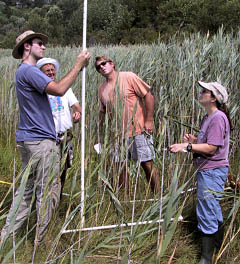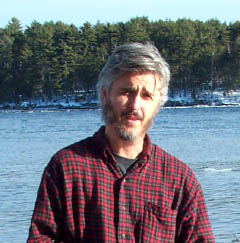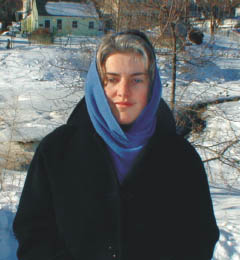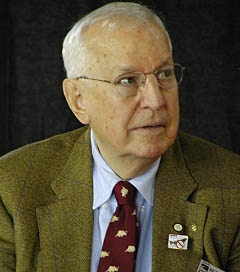 The hope and promise of a sustainable Gulf of Maine rests, in large part, on a rising, irrepressible chorus of voices of people from Massachusetts to Nova Scotia who are actively engaged in the overall health of their watersheds. Collectively, these are people, often thought of as visionaries, who share a deep devotion to improving the future well being of coastal lands and waters at the local level, and, who also understand how their actions ultimately benefit the entire Gulf region and beyond. One of the main purposes of the Gulf of Maine Council’s Visionary Awards, which are given each year, is to remind such stewards that they are not alone. As a show of gratitude, the awards honor the innovation and creativity of individuals and organizations from each state and province bordering the Gulf of Maine. Through their efforts and perseverance, these visionaries are working to protect one of the most productive and diverse ecosystems on Earth. Profiles
by Lori Valigra
Printer friendly page
 Staff and volunteers sampling vegetation on the Forest River in Salem
Courtesy of SSCW | | Salem Sound Coastwatch
Salem, Massachusetts Six quintessential New England communities north of Boston stretching from Marblehead to Manchester embrace the Salem Sound. For 14 years Salem Sound Coastwatch (SSCW), a nonprofit coastal watershed association, has worked to maintain the area’s good fishing, refreshing swimming, vital urban waterfronts and diverse plants and wildlife through extensive volunteer-based efforts.
Through the ambitious Wetland Health Assessment Toolbox (WHAT) Program started in 1999, SSCW and technical experts from the Massachusetts Bay’s National Estuary Program, the Massachusetts Office of Coastal Zone Management and other experts have trained 150 local “citizen scientist” volunteers to monitor wetlands. They measure seven parameters: birds, fish, macroinvertebrates, plants, salinity, tidal influence and land use. Data from the WHAT program already are being used to support local, state and federal wetlands restoration efforts. For example, about 20 percent of the regional marsh monitoring database at the Wells National Estuarine Research Reserve in Wells, Maine, comes from the WHAT program.
Other SSCW programs include Adopt-a-Tidepool, Clean Beaches and Streams, the recent Coastal Habitat Invasives Monitoring Program and the Anadromous Fish Run Restoration. Through the fish program, SSCW is working with the Massachusetts Division of Marine Fisheries to restore areas including the smelt-spawning habitat in the North River in Salem and Peabody. As recently as the 1970s, the river was a dumping ground for tannery waste and raw sewage, but smelt and other fish now have returned, says Barbara Warren, SSCW’s program director.
Warren adds that the SSCW plans to begin work on eelgrass conservation and to perform a Marine Sanitation Needs Assessment to study the sanitation practices of boaters.
In 1992, one of SSCW’s founding partners, Salem Partnership, was also given a Visionary Award for “its leadership as a business supporting environmental initiatives,” says Rob Gough, executive director. |  Stephen H. Jones
Courtesy S. Jones | | Stephen H. Jones, Jackson Estuarine Laboratory
Durham, New Hampshire Stephen H. Jones, research associate professor for natural resources and marine science at the University of New Hampshire, spends his days studying a sometimes perplexing, if not amusing, assortment of fecal pollutants in water. To help identify the species responsible for contamination, Jones set up a specialized lab at the university’s Jackson Estuarine Laboratory to conduct microbial source tracking (MST), a sophisticated genetic analysis of bacteria found in water. Other scientists have used the genetic methodology he employs, ribotyping, for about 10 years, but Jones has developed it as an environmental investigation tool for the Gulf of Maine region.
Jones’ database has information on 35 species in it, including cows, dogs and humans, as well as alpaca and muskrat. He admits that at times, he has been stumped by some of the results of his analysis. New Hampshire’s Department of Environmental Services once sent him samples from marshes behind beaches of the state’s Atlantic coast. Jones says he was dumbfounded when he traced the pollution back to otters. “It turns out the state sampled the water from a small creek where the otters had established areas to use as latrines,” he says.
Another puzzler was a sample that showed a 72-percent concentration of cat fecal bacteria. “We discovered it came from a storm conduit where a lady was putting down cat feces,” he says.
But such specificity can help the state solve problems and make better management decisions, Jones says. His other related research includes field evaluation of storm water treatment technologies for removing bacteria, studying the ecology of pathogens in shellfish and evaluating effluent from municipal wastewater treatment facilities. |  Tricia Miller
Photo: Steve Miller | | Tricia Miller, Advocates for the North Mill Pond
Portsmouth, New Hampshire Tricia Miller, vice president of the Advocates for the North Mill Pond (ANMP), only needed to look in her own backyard to find an environmental cause that could vitalize her community. Miller and her neighbors became alarmed by the deteriorating condition of Hodgson Brook, the freshwater stream that flows through the center of Portsmouth, New Hampshire, and into the North Mill Pond near their homes. A 46-acre salt pond, North Mill Pond also is fed by tidal waters of the Piscataqua River.
Hodgson Brook suffered from overdevelopment and years of neglect: dumped trash littered its banks and pollution poured into its waters. Teenage partiers and vagrants made the area increasingly unsafe. The neighborhood formed ANMP in 1997 to clean up and enhance North Mill Pond and its surroundings. In 2001, ANMP won a grant from the New Hampshire Department of Environmental Services to study Hodgson Brook and devise a restoration plan.
The University of New Hampshire tested the water to identify the pollutants. Miller says ANMP members removed the refrigerators, beds and other trash along the banks. The cleanup efforts soon paid off: striped bass, mummichogs and other fish and birds returned. The community became aware of the brook and pond as a natural area.
“By drawing from the diversity of the neighborhood and working in a positive way with the city and state, we’ve been able to accomplish an awful lot. This is backyard stewardship,” says Miller, a graphic artist whose skills have been critical to ANMP's success in developing the restoration plan and reaching out to watershed constituents. Members of the group, who volunteer their time and skills, include environmental scientists, a lawyer and an events manager. ANMP received an earlier Gulf of Maine Council visionary award in 1998. |  Bill Townsend
Courtesy Maine Rivers | | Clinton “Bill” Townsend
Canaan, Maine Bill Townsend, who is widely regarded as the dean of the conservation community in Maine, grew up loving hunting, fishing and virtually all outdoor activities. When he was in his 20s, just after World War II, he realized that rivers and other waterways would have to be taken care of so future generations could enjoy those same activities. Few environmental groups existed in the 1950s, which helped propel Townsend into action. “It was an epiphany,” he says, recalling a drive with his father through the Vermont countryside. “I was watching a blue stream. It then turned green, and then orange just around the corner from a woolen mill that was discharging a dye batch into it. That struck me as really wrong.”
Since then he has freely given his time and boundless energy to protect rivers and sea-run fish. His love of Atlantic salmon has driven many of his efforts and earned the respect of the international salmon community. He helped found the Maine Council of the Atlantic Salmon Federation and became its president in 1986. He also has served as president of Facilitators Improving Salmonid Habitat, a group that buys and then removes old dams, and has won numerous awards, including from the North Eastern Council Federation of Fly Fishers.
A New Yorker who vacationed summers on Cape Ann, Massachusetts, Townsend and his family moved to Maine in 1957. He was an attorney, but always found time to advocate for clean waters. “I can’t help myself,” he says. Known for his understated “country lawyer” style, he finds creative and balanced solutions that have had a profound impact on the Gulf of Maine’s health. Townsend, 77, says that when he eventually slows down, he’d like to “go fishing.” | © 2005 The Gulf of Maine Times |


